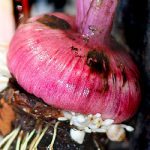 Short underground swollen stem, a storage stem.
Short underground swollen stem, a storage stem.
Bulblike, underground storage organ formed by a swollen stem base.
Swollen, usually spherical or rounded underground stem, capable of producing a new plant.
Modified underground stem base, fleshy and globose, bearing scaly leaves and bulbs.
The fleshy, bulblike, solid base of a stem, often rising out of a tuber or bulb.
An upright, hard, or fleshy stem surrounded by dry scaly leaves, as in the gladiolus bulb.
Short, thick, underground part of the stem serving as a storage device for the plant.
Short underground swollen stem (not the leaf bases) for storage.
A swollen rounded underground mass of so lid tissue at the base of a stem, eg, in a Crocus, not (as in a bulb) composed of layers of scales; each corm is of one year’s formation, the next yea r’s growth arising separately on top of it.
A bulb-like organ, usually growing underground but without the scales (fleshy modified leaves) of a bulb, and often simply called a bulb by gardeners, such as gladiolus and freesias. When a corm flowers the old corm dies and the plant creates a new one on top of it; bulbs are usually more or less permanent structures.
A bulb-like organ, usually growing underground but without the scales (fleshy modified leaves) of a bulb; a corm is in fact a kind of tuber, a condensed stem that stores food material, differing from other tubers in that it forms new corms at the apex and dies off behind at the base. Most cormous plants form a new corm annually. Gardeners often group cormous plants under the general heading of bulbs.
A short, bulb-shaped underground stem of a plant such as the autumn crocus, a source of colchicine.
The short, underground, bulblike base of a stem that lasts one year, that of the next year growing at the top of the old one.
Specialized, fleshy stem bases that function for storage and reproduction.
